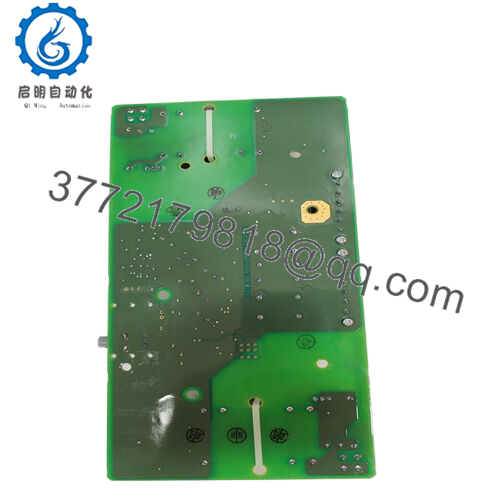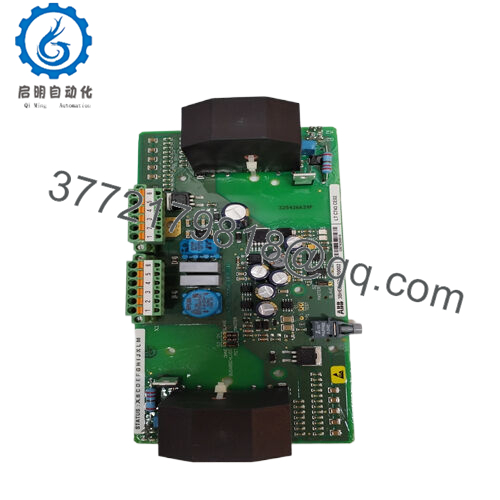Description
| Model Number | 3BHE013299R0002 |
| Brand | ABB |
| Type | Dedicated Power Unit for Turbine Control Systems |
| Input Voltage | 110/230V AC (auto-ranging, 50/60Hz) |
| Output Voltage | Regulated 24V DC (±0.5% tolerance) |
| Operating Temp Range | -5°C to 65°C (23°F to 149°F) |
| Mounting Style | TCS Cabinet Backplane (compatible with ABB Turbine Control enclosures) |
| Dimensions | 45mm (W) x 130mm (H) x 140mm (D) |
| Weight | 0.55kg (1.21lbs) |
| Interface/Bus | ABB Proprietary Turbine Control Bus; diagnostic signal via 4-20mA |
| Vibration Resistance | Up to 5g peak (IEC 60068-2-6) |
| Compliance | CE, UL 508, IEC 61508 (SIL 2), RoHS, IEC 61000-6-2 (EMC) |
| Supported Protocols | ABB TCS Bus; compatible with ABB Control Builder M |
| Typical Power Draw | 80W (max output), 6.5W (no-load standby) |

3BHE013299R0002
The ABB 3BHE013299R0002 operates as a dedicated power unit in ABB’s turbine automation stack, converting incoming AC power (from the facility’s main grid or backup generator) to regulated 24V DC power for ABB’s turbine control components—including speed controllers, position sensors, and emergency shutdown (ESD) logic solvers. Unlike generic industrial power supplies, it’s designed to integrate seamlessly with ABB’s Turbine Control System (TCS) architecture, mounting directly to the TCS cabinet’s backplane and communicating with the central controller via ABB’s proprietary bus protocol.

3BHE013299R0002
This integration enables real-time monitoring of power unit performance: via ABB’s Control Builder M software, engineers can track output voltage, load levels, and internal temperature, receiving instant alerts for issues like overcurrent or voltage drift before they impact turbine control. The unit also features robust vibration resistance (up to 5g peak, per IEC 60068-2-6) and EMI shielding—critical for turbine environments where generator noise and mechanical vibration often disrupt standard power supplies. By acting as the power backbone for ABB’s turbine control system, the ABB 3BHE013299R0002 ensures that every critical turbine function receives consistent, reliable power—even in the most demanding operational conditions.
Main features and advantages:
Choosing the ABB 3BHE013299R0002 delivers critical value for turbine operations, where power reliability directly impacts safety and productivity. Its tight output voltage tolerance (±0.5%) ensures that ABB’s turbine speed controllers and valve actuators receive precise power—preventing the erratic turbine behavior that can occur with less regulated supplies (e.g., speed fluctuations or incorrect valve positioning). This precision translates to improved turbine efficiency: consistent power delivery helps maintain optimal turbine speed and load, reducing fuel consumption in gas/steam turbines by up to 2% compared to systems using generic power units. The unit’s SIL 2 compliance also simplifies safety certification for turbine systems, eliminating the need for additional safety components that add cost and complexity. Over time, the ABB 3BHE013299R0002’s rugged design minimizes maintenance: its vibration-resistant components and wide temperature range reduce wear and tear, resulting in a mean time between failures (MTBF) of over 150,000 hours—far longer than standard industrial power supplies. For engineers, this means fewer unplanned turbine shutdowns and more time focused on optimizing performance rather than troubleshooting power issues.
Application fields:
The ABB 3BHE013299R0002 is purpose-built for industries where turbine reliability is mission-critical, excelling in three key sectors. In power generation, it supplies power to ABB’s steam and gas turbine control systems in coal-fired, natural gas, and combined-cycle power plants—ensuring that turbines maintain stable output even during grid voltage fluctuations. In oil and gas refining, it powers ABB’s turbine control modules for process turbines (e.g., those driving compressors or pumps), withstanding the high vibration and temperature swings of refinery environments to prevent costly process interruptions. It’s also critical in hydroelectric power plants, where it delivers reliable power to ABB’s hydro turbine control systems—operating seamlessly in damp, high-humidity conditions that would degrade non-specialized power units. In each use case, the ABB 3BHE013299R0002 meets the demands of 24/7 turbine operation: its EMI shielding blocks noise from turbine generators, while its overcurrent protection prevents damage to control components during electrical surges—ensuring that turbines remain safe, efficient, and compliant with industry standards.
Related products:
ABB 3BHE013299R0001 – Lower-power variant (60W) for small-scale turbine control systems (e.g., micro-hydro turbines).
ABB 3BHE013299R0003 – Higher-power model (100W) for large industrial turbines (e.g., 50MW+ steam turbines).
ABB 3BHE013299R0004 – Redundant power unit for SIL 3 turbine safety systems (e.g., emergency shutdowns).
ABB 3BHE013299R0005 – Extended-temperature variant (-20°C to 70°C) for cold-climate hydroelectric or offshore turbine systems.
ABB 3BHE013299R0006 – DC-input model (48V DC in) for turbine systems powered by backup batteries (e.g., remote power plants).
ABB 3BHE013299R0002 + 3BHE013300R0001 – Bundle with power monitoring module for real-time turbine power usage tracking.
ABB 3BHE013299R0007 – High-isolation variant (3kVrms) for turbine systems in high-voltage power substations.
Installation and maintenance:
Before installing the ABB 3BHE013299R0002, first verify compatibility with your ABB turbine control system: it is designed for use with ABB AC 800M TCS v6.0 or later, so older TCS versions may require a firmware update to support the unit’s diagnostic features. Next, calculate the total load of connected turbine control components (e.g., speed sensors, ESD modules) to ensure it does not exceed the 80W max output—overloading can trigger the unit’s protective shutdown, which may cause an unexpected turbine trip. During setup, use a calibrated multimeter to confirm the input voltage matches your facility’s power (110V or 230V AC) and ensure the unit is mounted securely to the TCS backplane—loose mounting can increase vibration stress on components. For maintenance, conduct monthly checks of the unit’s LED status indicators: a steady green light confirms normal operation, while a red light signals a fault (e.g., overheating or overcurrent) that requires immediate attention. Every six months, inspect the unit’s connectors for corrosion (common in hydroelectric plants) and clean them with a dry, lint-free cloth—corroded connectors can cause voltage drops that disrupt turbine control. Annual functional testing, using a variable load bank to simulate peak turbine control demand, ensures the unit maintains its tight voltage tolerance over time.
Other ABB product models:
ABB 3BHE030579R0003
ABB 1SVR040000R1700
ABB UAD155A0111 3BHE029110R0111
ABB 1TGE120040R0010
ABB DCF506-0140-51-0000000
ABB PCD530
ABB 1TGE120016R0104
ABB 1MRK000614-AB
ABB 5SHY35L4510
ABB PYT0450W071A
ABB DKTFM418B 3BHB015651P0001
ABB REF620E-1G NBFNAANNNEA1BNF11G
ABB PM858K02 3BSE082896R1
ABB PM902F 3BDH001000R0001
ABB KSD211B101 3BHE022455R1101
ABB PM863K02 3BSE088382R1
ABB SM812K01 3BSE072270R1
ABB UNS0867 HIEE405246R0002
ABB El3020 URAS26
ABB PM803F
ABB REF601BE446BD1NH
ABB 3BHE022287R0001
ABB PFTL101A-2.0KN 3BSE004172R1
ABB PTPU-02 3HNA023148-001
ABB UNITROL1020
ABB 3HAC028357-001
ABB 3BSE003832R1 SC510
ABB LM200
ABB SPAJ110C
ABB 1KHL178016R0001F
ABB 1KHL160038R0104D
ABB UP10C01000
ABB LD800HSE 3BDH000320R02
ABB 5SHY35L4520 5SXE10-0181
ABB VP01 2VAA008172R01

 WhatsApp: +86 16626708626
WhatsApp: +86 16626708626 Email:
Email:  Phone: +86 16626708626
Phone: +86 16626708626


